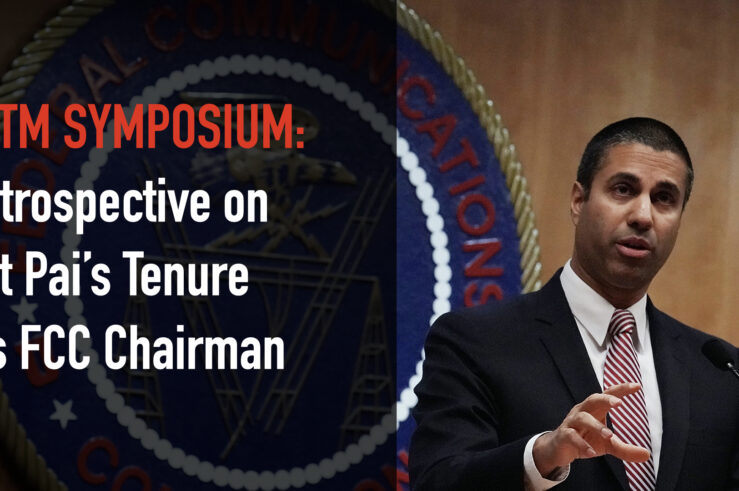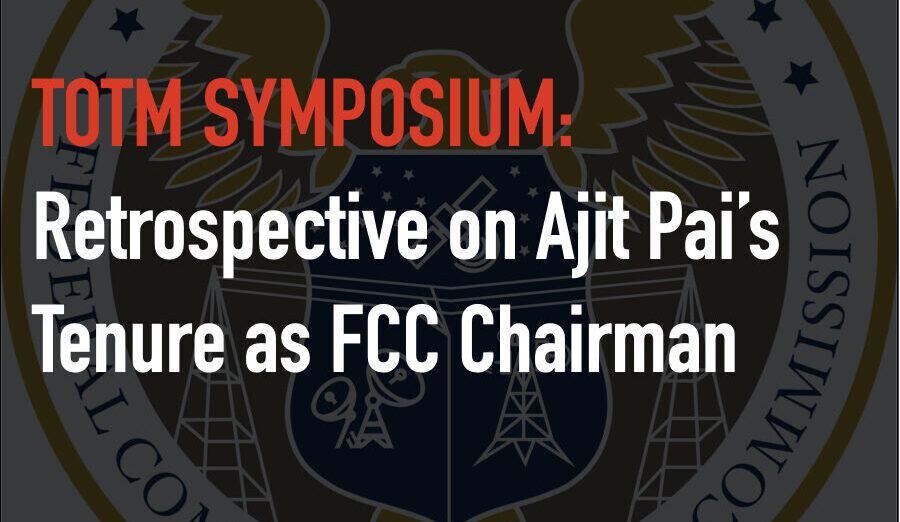
This article is a part of the Retrospective on Ajit Pai's Tenure as FCC Chairman symposium.

Chairman Ajit Pai will be remembered as one of the most consequential Federal Communications Commission chairmen in history. His policy accomplishments are numerous, including the repeal of Title II regulation of the internet, rural broadband development, increased spectrum for 5G, decreasing waste in universal service funding, and better controlling robocalls.
Less will be said about the important work he has done rebuilding the FCC’s independence. It is rare for a new FCC chairman to devote resources to building the institution. Most focus on their policy agendas, because policies and regulations make up their legacies that the media notices, and because time and resources are limited. Chairman Pai did what few have even attempted to do: both build the organization and make significant regulatory reforms.
Independence is the ability of a regulatory institution to operate at arm’s length from the special interests of industry, politicians, and the like. The pressures to bias actions to benefit favored stakeholders can be tremendous; the FCC greatly influences who gets how much of the billions of dollars that are at stake in FCC decisions. But resisting those pressures is critical because investment and services suffer when a weak FCC is directed by political winds or industry pressures rather than law and hard analysis.
Chairman Pai inherited a politicized FCC. Research by Scott Wallsten showed that commission votes had been unusually partisan under the previous chairman (November 2013 through January 2017). From the beginning of Reed Hundt’s term as chairman until November 2013, only 4% of commission votes had divided along party lines. By contrast, 26% of votes divided along party lines from November 2013 until Chairman Pai took over. This division was also reflected in a sharp decline in unanimous votes under the previous administration. Only 47% of FCC votes on orders were unanimous, as opposed to an average of 60% from Hundt through the brief term of Mignon Clyburn.
Chairman Pai and his fellow commissioners worked to heal this divide. According to the FCC’s data, under Chairman Pai, over 80% of items on the monthly meeting agenda had bipartisan support and over 70% were adopted without dissent. This was hard, as Democrats in general were deeply against President Donald Trump and some members of Congress found a divided FCC convenient.
The political orientation of the FCC prior to Chairman Pai was made clear in the management of controversial issues. The agency’s work on net neutrality in 2015 pivoted strongly toward heavy regulation when President Barack Obama released his video supporting Title II regulation of the internet. And there is evidence that the net-neutrality decision was made in the White House, not at the FCC. Agency economists were cut out of internal discussions once the political decision had been made to side with the president, causing the FCC’s chief economist to quip that the decision was an economics-free zone.
On other issues, a vote on Lifeline was delayed several hours so that people on Capitol Hill could lobby a Democratic commissioner to align with fellow Democrats and against the Republican commissioners. And an initiative to regulate set-top boxes was buoyed, not by analyses by FCC staff, but by faulty data and analyses from Democratic senators.
Chairman Pai recognized the danger of politically driven decision-making and noted that it was enabled in part by the agency’s lack of a champion for economic analyses. To remedy this situation, Chairman Pai proposed forming an Office of Economics and Analytics (OEA). The commission adopted his proposal, but unfortunately it was with one of the rare party-line votes. Hopefully, Democratic commissioners have learned the value of the OEA.
The OEA has several responsibilities, but those most closely aligned with supporting the agency’s independence are that it: (a) provides economic analysis, including cost-benefit analysis, for commission actions; (b) develops policies and strategies on data resources and best practices for data use; and (c) conducts long-term research. The work of the OEA makes it hard for a politically driven chairman to pretend that his or her initiatives are somehow substantive.
Another institutional weakness at the FCC was a lack of transparency. Prior to Chairman Pai, the public was not allowed to view the text of commission decisions until after they were adopted. Even worse, sometimes the text that the commissioners saw when voting was not the text in the final decision. Wallsten described in his research a situation where the meaning of a vote actually changed from the time of the vote to the release of the text:
On February 9, 2011 the Federal Communications Commission (FCC) released a proposed rule that included, among many other provisions, capping the Universal Service Fund at $4.5 billion. The FCC voted to approve a final order on October 27, 2011. But when the order was finally released on November 18, 2011, the $4.5 billion ceiling had effectively become a floor, with the order requiring the agency to forever estimate demand at no less than $4.5 billion. Because payments from the fund had been decreasing steadily, this floor means that the FCC is now collecting hundreds of billions of dollars more in taxes than it is spending on the program. [footnotes omitted]
The lack of transparency led many to not trust the FCC and encouraged stakeholders with inside access to bypass the legitimate public process for lobbying the agency. This would have encouraged corruption had not Chairman Pai changed the system. He required that decision texts be released to the public at the same time they were released to commissioners. This allows the public to see what the commissioners are voting on. And it ensures that orders do not change after they are voted on.
The FCC demonstrated its independence under Chairman Pai. In the case of net neutrality, the three Republican commissioners withstood personal threats, mocking from congressional Democrats, and pressure from Big Tech to restore light-handed regulation. About a year later, Chairman Pai was strongly criticized by President Trump for rejecting the Sinclair-Tribune merger. And despite the president’s support of the merger, he apparently had sufficient respect for the FCC’s independence that the White House never contacted the FCC about the issue. In the case of Ligado Networks’ use of its radio spectrum license, the FCC stood up to intense pressure from the U.S. Department of Defense and from members of Congress who wanted to substitute their technical judgement for the FCC’s research on the impacts of Ligado’s proposal.
It is possible that a new FCC could undo this new independence. Commissioners could marginalize their economists, take their directions from partisans, and reintroduce the practice of hiding information from the public. But Chairman Pai foresaw this and carefully made his changes part of the institutional structure of the FCC, making any steps backward visible to all concerned.



